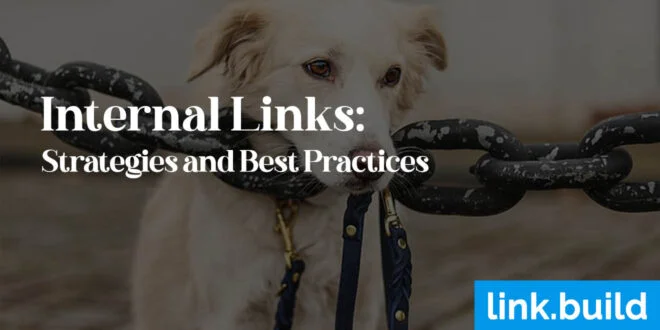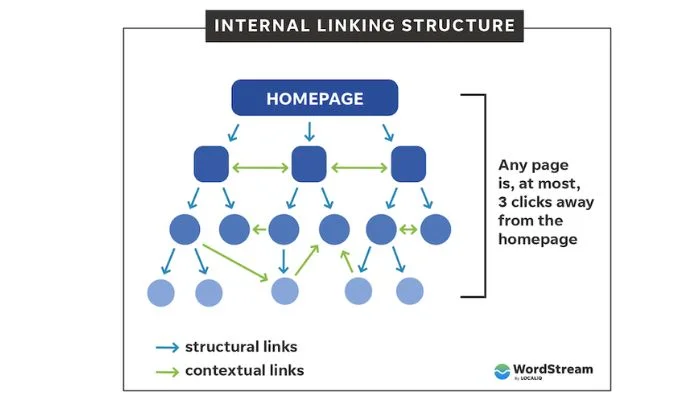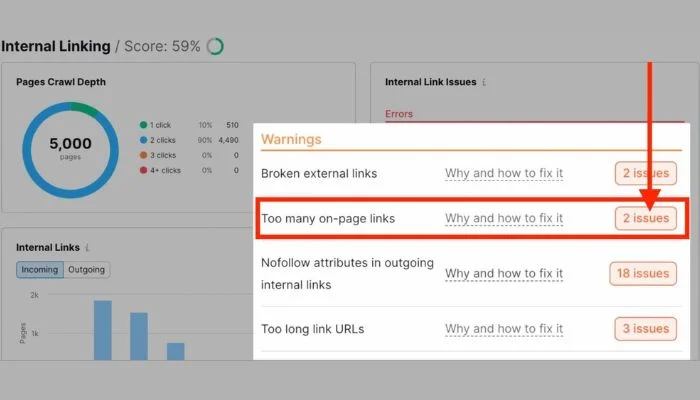Internal Links: Strategies and Best Practices

Effective web optimization requires internal links. When they're used well, internal links bring website, visitors, exactly where you want them to go and make doing business easier for both them and you.
Knowing the value of an internal link in website optimization.
This comprehensive guide will explore the definition, purpose, and best practices of utilizing different types of internal link structures.
It further offers insight into key strategies applied in practice together with advanced techniques as well as recommended tools essential for maximum benefit from an effective internal linking approach. This guide should help all levels of site owners build an optimized, future-proofed integrated link network.
Understanding Internal Links

Internal links are components of web pages that allow users to navigate between other pages within the same website. In other words, they form pathways between different parts and functions within a single site.
Whether it is in the text or accompanying menu bar, internal linking helps organize and structure the content so that users find what they need quickly and effectively. Furthermore, good internal links have the potential to enhance website performance given that it increases crawlability and visibility across search engine result pages (SERPs).
Additionally, strategically placed internal links can maintain user engagement by maintaining visits while increasing amount page views per user session. Hence, an effective use of internal linking proves essential for effective SEO marketing strategies.
Different types of internal links
Internal links are important elements of SEO used to direct readers from one page of a website to another. Generally differentiated by the href attribute, they can be divided into hierarchical internal links that link to content further up the structure and cross-linking, which directs users from two isolated pages.
Links may also be categorized as deep-linking – pointing viewers towards lower-level pages – or shallow-linking – connecting them to higher leveled ones like the homepage. Near-end variables such as the kind of link sequence depicting Nofollow (which reduces search index frequency) as opposed to Dofollow (which has contrary implications) should also be considered while internal linking.
How internal links affect SEO
Internal links affect SEO by helping search engine crawlers navigate your website and access content more easily. They also help create relevance between pages, as the algorithm looks to see if the two linked pages are related to each other topic-wise or not, which is advantageous for high-Quality Scoring when it's done correctly.
Internal links can also improve user experience on your website by providing navigation assistance for readers so they spend long periods of time exploring new areas that might be of interest.
Additionally, internal linking makes it easier for social media users looking to link back to internal content that is insightful or entertaining. More importantly, these good interlinks increase the conversion rate of visited pages within Google searches potentially doing wonders for companies' goods and services available online.
Key Strategies for Effective Internal Linking
Conducting a website audit to identify internal linking opportunities
Conducting a website SEO audit is crucial to successful internal linking as it provides insight into the distribution of content across your site.
Pathway analysis, broken link checks, and semantic query optimization are all important considerations for creating effective internal links. Cultivating an inventory of existing page titles as well pathways in which to quickly navigate these pages through internal links is key in strategically optimizing overall site performance.
This can be accomplished by conducting keyword research to uncover additional opportunities for optimization and ensuring that anchor text accurately reflects the destination page's topic or goal while properly maintaining relevancy and context within one's web pages. Positioning conceptually similar keywords near each other further strengthens the relationship between them in search engine ranking.
Creating a hierarchical structure for internal links

Creating a hierarchical structure for internal links is an important best practice in SEO. This strategy involves organizing your website's content into distinct categories and structuring the page link trees accordingly. The primary benefit of this approach is that it helps visitors find relevant pages quickly and easily, increasing user experience and lowering bounce rates as a result.
It also plays an important role from an SEO perspective by allowing search engine spiders easy access to new landing pages, integrating keyword terms into any related anchor text tags found within those links, as well as boosting overall sitemap crawler performance during link analysis checks. In addition, leveraging hierarchy also passes additional referral value from one webpage to another based upon established classification orderings within the site architecture.
Optimizing anchor text for better SEO
An important part of an effective internal linking strategy is optimizing the anchor text for better SEO. Anchor text refers to the visible wording that links from one web page to another within a website.
Whenever possible, include descriptive terms and relevant keyword phrases in the hyperlinked anchor text as this tells search engine robots what page is being linked to, optimizing ranking according to the user's intentions.
However, it's also necessary not to link two overly similar tasks and balance between exact matching keywords used too liberally or general descriptive terms instead. This technique allows Google bots to index your content appropriately associated with your website domain which can increase visibility on their results pages.
Using descriptive and keyword-rich anchor text
Using descriptive and keyword-rich anchor text is one of the key strategies for effective internal linking. Entering specific words or phrases to connect from one page to another can significantly improve a website's SEO.
Anchor text that accurately describes the destination page content and uses relevant keywords will help to boost SEO rankings by optimizing the link as well as providing additional information about its purpose or direction. Link titles should be kept short, concise, and consistent while extra attention should be paid to important landing pages in order to reinforce their relevance.
Quality anchor text is thus productive both inside individual webpages and when spanning across the site, helping readers quickly access targeted material more easily while improving overall search engines visibility.
Distributing internal links strategically throughout the website
Although all the strategies mentioned for effective internal linking are important, strategic distribution of internal links throughout a website can have an immense impact.
It is essential to carefully balance the number of internal links across different pages and also consider user experience when placing your links. Make sure that you don't overwhelm your reader with too many link anchor texts cluttering a page but instead demonstrate restraint by strategically deploying them on key sections.
Additionally, ensure that you distribute your authoritative webpages' links in high-performing locations so that it increases their search visibility, helping those rank ahead of others among related keywords. Pay special attention to how various anchor texts on different pages interrelate with each other bringing together interesting ideas or internal links pointing readers towards more resourceful content.
And yes, there is such a thing as too many internal links. So link with care.
Incorporating internal links in navigational menus and sidebars
Incorporating internal links into navigational menus and sidebars is essential when it comes to effective internal linking. These areas should link to the most important pages you want visitors on your website or page to access quickly.
It's typically best practice to use concise, descriptive anchor text that accurately describes the content of the page you are linking to in menu and sidebar links, as this improves user experience by giving visitors immediate context for each link they encounter.
Carefully crafting these two aspects allows web designers an easy way of distributing beneficial internal links around their sites in order to make information more accessible whilst improving site SEO.
Utilizing breadcrumb navigation for enhanced user experience
Breadcrumb navigation is an effective tool for creating internal links and providing more user-friendly browsing experiences. It helps to provide a pathway to users that displays the hierarchy of the website, making it easier for visitors to find what they are looking for with minimal effort.
Its visual presentation eliminates confusion and encourages click-through from page to page by emphasizing URLs, which makes breadcrumbs helpful in improving SEO and link structure.
Utilizing breadcrumb navigation should include optimizing keywords, making sure all relevant content are included in some manner on both the functions pane as well as any site navigations, creating clear hierarchical diagrams, anchoring text, actively monitoring placement feedback, and analyzing performance metrics over time.
Best Practices for Internal Linking
Keeping internal links relevant and contextually appropriate
Best practices for internal linking include keeping the links relevant and contextually appropriate. This is important because if an irrelevant link that doesn't fit into the content is clicked, it could deteriorate user experience and harm SEO. Contextual relevance should be considered, along with all important internal links.
The target page should contextualize and help the reader understand what the page they are clicking on will provide and how it relates to their original request, thus creating a stronger connection back to your website.
Also, keep in mind natural language- when possible use natural keywords phrase rather than single words so readers can better understand what your link topic contains as well as something closely associated with that topic for added clarity and accuracy.
Balancing the number of internal links on a page

To ensure the effectiveness of internal linking, it is important to balance the number of links on a page. Too many links can decrease user experience and potential conversions. Incorporating too few runs the risk of missing chances for SEO optimization.
A good rule of thumb is to include fewer than 100 words per link within blog post or content pages and limit inside-page navigation menu options to five to eight if possible.
Finally, striking an ideal balance between keyword-rich anchor text and direct calls-to-action, along with using descriptive link labels, is important when keeping tabs on how many internal links are sensibly placed throughout a website's hierarchy.
Avoiding excessive internal linking and over-optimization
To ensure efficient internal linking, it is important to avoid excessive internal linking and over-optimization of anchor text. Site owners should limit the total number of links per page in order to prevent overwhelming web visitors.
Excessively optimizing anchor text through link spamming or keyword stuffing can lead to search engine repercussions, so it is best to keep content sounding natural and use variations in phrases when using keywords multiple times throughout a website.
Finally, keeping up with regularly updating and monitoring existing links will also help ensure an effective online presence.
Updating and maintaining internal links over time
Updating and maintaining internal links over time is an important best practice for optimizing a website's technical performance. Not only should the strong internal linking structure reflect the latest content relationships, but outdated or broken internal links can negatively affect user experience by creating annoying 404 error messages.
Regular internal link auditing will stimulate better indexability for web crawlers, optimize search engine visibility, and efficient navigation through fresh website resources with no harmful UX issues.
Content refreshes in particular ought to be accompanied by corresponding interlinking modifications in order to protect the SEO advantage of secure web page ranks for related external links or pages declared in each old/new source code version respectively.
Monitoring and analyzing internal link performance
Monitoring and analyzing internal link performance is essential for both optimizing user experience and driving SEO value. Internal links can be traced by traffic distribution data, bounce rates, page views, total average session duration and other metrics that provide a deeper understanding of navigation patterns or levels of engagement with content.
To drill down further to uncover areas needing improvement, tools such as Broken Link Checker and Xenu's Link Sleuth are helpful in finding broken pages on your site or promoting better navigation. Analytics platforms can go even further to provide insight on particular sections being missed more often than others along the click trail.
Taking everything into consideration will better equip any website optimization strategy when it comes to keeping performance tracking organized for each internal link page now -- and going forward.
Conclusion
In conclusion, website optimization involves the utilization of effective internal link strategies. A solid internal linking structure should be created to better effectual navigation through website pages and content. Anchor texts optimized for keywords as well as relevant and descriptive terms should be distributed around the page strategically paired with text links that are contextually correct.
Also, constantly manage and test your quality of internal linking performance by continually auditing your site in order to stay abreast with current technology trends related to website personalization. All these practices will ultimately produce optimal outcomes from this simple yet important aspect of web development - SEO-friendly internal links.


.svg)

.jpg)
.jpg)
.jpg)